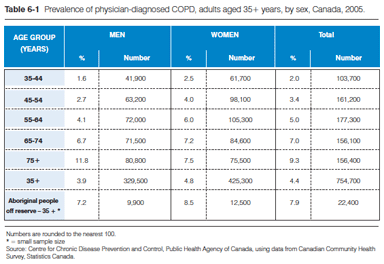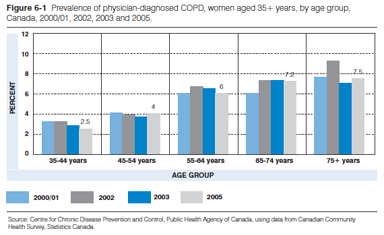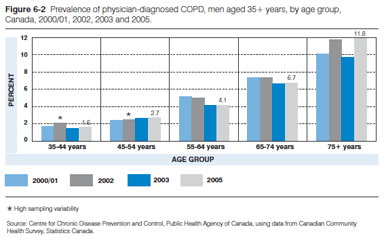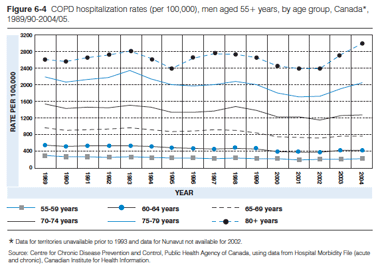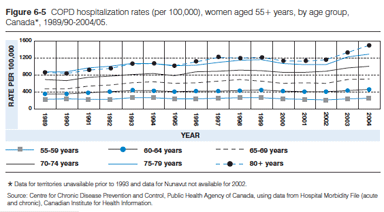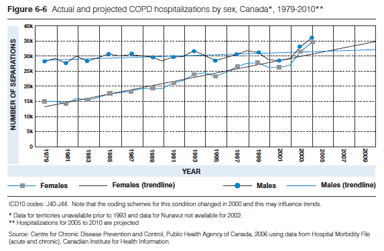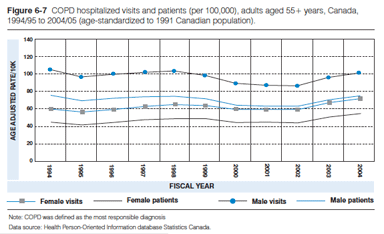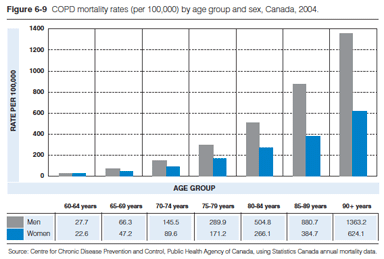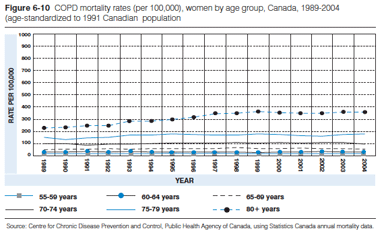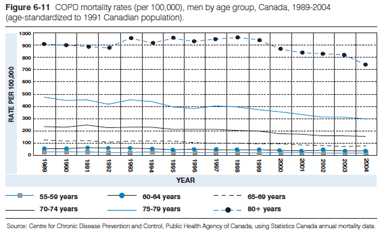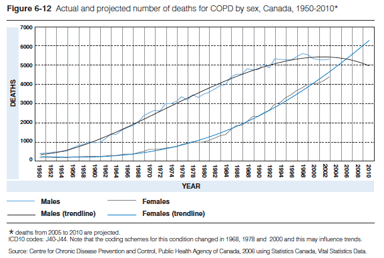COPD
Introduction
Chronic obstructive pulmonary disease (COPD) is a chronic disease characterized by shortness of breath, cough and sputum production.1 Its symptoms do not usually appear in people younger than age 55. The changes to the lung, however, begin many years earlier. Chronic bronchitis and emphysema are the two most common underlying processes that contribute to COPD.
COPD progresses slowly over a period of years. Increasing disease severity is associated with more frequent exacerbations, further reductions in airflow and premature death. As the disease advances, shortness of breath limits the activity levels of individuals and reduces their quality of life. In its more severe stages, the effects of the disease are felt more frequently, often resulting in further reductions in airflow and premature death. Families also face two challenges: first, of providing an increasing level of care; and second, watching the progression of the disease in their loved one. The costs associated with COPD—loss of productivity and the need for additional services—affect the family, the health care system and the community as a whole.
Risk Factors
Several modifiable risk factors contribute to COPD.2 In 80% to 90% of cases, cigarette smoking is the principal underlying cause. The contribution of primary smoking is very clearly established, and exposure to second-hand smoke (SHS) likely also plays an important, if less well defined, role. Another major risk factor is occupational exposure to dusts (e.g., cadmium dust, gold dust, coal dust, grain dust) and some fumes. Exposure to non-specific dust is likely to add to the effect of smoking. Outdoor air pollution is associated with increased symptoms among those with COPD, including shortness of breath. Repeated childhood respiratory tract infections and childhood exposure to second-hand smoke (SHS) lead to reduced levels of respiratory function, which may predispose to COPD. A genetic deficiency of alpha-1-antitrypsin, an anti-protease which protects the lung tissue from damage, is also associated with an increased risk of COPD.
Prevalence
Of adults over the age of 34 surveyed in the Canadian Community Health Survey (CCHS) of 2005, 4.4% (3.9% of men [329,500] and 4.8% of women [425,300]) reported that they had been diagnosed by a health professional with COPD (includes self-report of COPD, chronic bronchitis or emphysema). Results from the same survey indicate that among Aboriginal people living off reserve, 7.9% have COPD (Table 6-1). Unfortunately, since the early symptoms of the disease are often not recognized, many individuals do not seek treatment. Results from a recent Burden of Obstructive Lung Disease study conducted in Austria indicate that self-reported physician diagnosed COPD may underestimate the prevalence by at least 50% in individuals 40 years of age and over.3 Consequently, these figures may under-represent the actual prevalence of COPD in the population. In addition, the diagnostic challenges in differentiating between asthma and COPD among older smokers may result in the misclassification of one disease as the other. As a result, data for the older age groups must be interpreted with caution.
The proportion of individuals diagnosed with COPD increases with age. In 2005, a higher proportion of women than men under the age of 75 had been diagnosed with COPD; this trend reversed, however, in the 75+ age group (Table 6-1). The difference between men and women in the older age group is a function of the higher prevalence of smoking in men than in women 50 years ago. The higher prevalence of COPD among younger women may reflect the greater sensitivity of women to the harmful components of tobacco smoke.4 It may also reflect differences in the health care-seeking behaviours of men and women. Women tend to visit their physicians more often than men and therefore may be diagnosed earlier with COPD.
From 2001 to 2005, the yearly prevalence of self-reported COPD among women and men varies a little, but more years of data are required before a specific trend can be identified (Figures 6-1 and 6-2).
Almost 84% of Canadians over 35 years of age with self-reported COPD were or had been smokers (91% of men; 77% of women) and almost 40% of those were still smoking (Table 6-2).
Hospitalization
Hospitalization may be required in the treatment of COPD, particularly when symptoms worsen from infection. In 2004–05, the average length of stay in hospital for individuals aged 55 and over with COPD was 9.6 days.
In 2004–05, hospitalization rates for COPD increased steadily by age for both men and women after age 55. Rates were higher for men than women, particularly among the elderly. This is consistent with the higher smoking rates among men 40 to 50 years ago (Figure 6-3). While the hospitalization rates for COPD among men have been decreasing (see Figure 6-4), the numbers have been increasing because the number of older men has been increasing.
Hospitalization rates for each age group of men decreased slightly during the 1980s and 1990s, with the exception of men 80 years of age and over (Figure 6-4). The change to more community-based care in the delivery of health services may have contributed to this trend.
In contrast, hospitalization rates between 1989 and 2004–05 for COPD rose in all age groups for women aged over 60 years. This may reflect the increase in smoking among women in the past contributing to COPD now (Figure 6-5). Not only the rate, but the number of women hospitalized with COPD increased in the 1990s, and this trend is expected to continue (Figure 6-6). An increase over time in the number of older women in the population contributes to this trend.
Men aged 55 and over are more likely to be hospitalized for COPD than women of the same age, and men have more frequent hospital visits, either in the form of readmissions or transfers to other institutions (Figure 6-7).
Respiratory viral infections, especially rhinoviruses, are a major cause of COPD exacerbations, with upper respiratory tract infections being associated with over 50% of COPD exacerbations.5, 6 COPD is the main risk factor for influenza-related hospital admissions and deaths. Based on death certificates, COPD was identified as the underlying cause of death in only 15% of deaths attributable to influenza.7 However, hospitalization records reveal COPD to have been a diagnosed co-morbidity factor in over 50% of all deaths attributed to influenza.8 Depending on the severity of the circulating strain, COPD can account for as much as 50% of all influenza-attributed hospital admissions among seniors.9
Emergency room visits in Ontario for COPD in people over age 50 peak in mid-winter and matched the pattern of emergency room visits for respiratory tract infections for people over the age of 50 (Figure 6-8).
Home Care
COPD is a chronic disease that leads to a progressive loss of function. Home care services can enhance the quality of life for individuals with COPD by making it less necessary for them to be hospitalized. The CCHS, 2005, indicated that 16.8 % of individuals with COPD had received home care services in the preceding 12 months. The highest use was among those aged 75+ years (36.7%).
Activity Restriction
Quality of life deteriorates progressively in individuals with COPD. According to the 2005 CCHS, 45.0% of individuals with self-reported COPD reported that they often experienced a restriction in their activity at home, at work, or in other activities, and an additional 24.6% reported an occasional restriction. This has important implications for rehabilitation programs.
Mortality
In 2004, COPD was the cause for 5,152 deaths among men and 4,455 among women in Canada – 4% of all deaths. The actual mortality rate may be higher because two complications of COPD, pneumonia and congestive heart failure, may be listed as the cause of death for individuals with COPD. The underlying causes of death or comorbidities are not included in the COPD mortality statistics reported here.
In 2004, mortality rates due to COPD increased sharply after age 70, and rates were higher for men than women after this age (Figure 6-9). This difference reflects the higher rate of smoking among men 50 years ago.
Mortality rates due to COPD among women over age 75 increased between 1987 and 1998, particularly for women over the age of 80 years, but these rates stabilized between 1998 and 2004 (Figures 6-10 and 6-11). The increased mortality rate combined with more older women in the population has resulted in a dramatic increase in the number of women dyong of COPD from 1980 to 2004 (Figure 6-12). If present trends continue there will be more women than men dying of COPD by 2008. Rates among men of all ages have decreased slightly during this time period with the biggest decrease among men over age 80 (Figures 6-10 and 6-11).
Discussion and Implications
COPD continues to be a common and important health problem among Canadian adults, and the number of individuals with COPD is likely to increase as the population ages. Tackling this challenge will require a strong, co-ordinated response by government, health care providers, volunteer organizations, patient advocacy groups and community organizations.
While in the past COPD was much more common among men than women of all ages, the prevalence of COPD is now higher among women than men in individuals under age 74. This pattern will continue, and with it will come major implications for families and the health care system. Since a high proportion of older women live alone, the need will increase for home care, supportive housing and other community services.
The management of COPD involves the early diagnosis and treatment of symptoms, such as shortness of breath and cough. It also requires efforts to slow the progression of the disease and optimize functional ability.10 The potential for the greatest gains in preventing COPD lie in smoking prevention and cessation (See also Chapter 2). Cessation of smoking can do a great deal to slow the progression of the disease. Involvement of the individual and family in all aspects of care is essential to improve health outcomes. Programs and services such as home care, home oxygen, supportive housing and pulmonary rehabilitation, provided in a supportive community environment, can meet the needs of individuals with COPD and their families. Improving indoor and outdoor air quality would eliminate several factors that exacerbate symptoms of COPD (See Chapter 3).
The increase in the number of people with COPD will require the expansion of existing services in primary care, emergency, hospital, specialist care, pulmonary rehabilitation, home care and home oxygen use. Providing the optimal level of rehabilitation services in the community will be a particular challenge. Currently, these services are primarily hospital-based. In the future, they will require an increase in funding levels and the re-organization of delivery methods, locations and providers.
Monitoring COPD more effectively will require a more comprehensive surveillance system. While the data from the CCHS give some sense of the number of people who have been diagnosed with COPD, it misses those who are unaware they have the disease. A population survey that includes assessing lung function with spirometry—such as Statistics Canada’s planned 2008 Canadian Health Measures Survey—would provide a more complete picture of the prevalence of COPD in the population. In addition, data on the use of health services other than hospital services, such as home care, oxygen therapy and pulmonary rehabilitation, would provide fuller information for the identification of the need for new or enhanced programs and services. Finally, population surveys to assess the impact of the disease and the quality of life of those with COPD would add another dimension to the data on health outcomes.
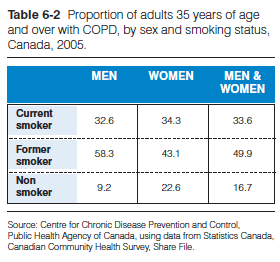
1 Ferguson GT, Cherniak RM. Management of chronic obstructive pulmonary disease. N Engl J Med 1993; 328(14):1017-22.
2 Silverman EK, Speizer FE. Risk factors for the development of chromic obstructive pulmonary disease medical clinics of North America 1996;80:3:501-22.
3 Schirnhofer L, Lamprecht B, Vollmer WM, Allison MJ, Studnicka M, Jensen RL, Buist AS. COPD prevalence in Salzburg, Austria: results from the Burden of Obstructive Lung Disease (BOLD) Study. Chest. 2007 Jan; 131(1): 29-36
4 Chen Y, Horne SL, Dosman JA. Increased susceptibility to lung dysfunction in female smokers. Am Rev Respir Dis 1991;143:1224-30.
5 Wedzicha JA. Role of Viruses in Exacerbations of Chronic Obstructive Pulmonary Disease. Proc Am Thorac Soc. 2004; 1(2):115-120.
6 Mallia P, Contoli M, Caramori G, Pandit A, Johnston S, Papi A. Exacerbations of asthma and chronic obstructive pulmonary disease (COPD): focus on virus induced exacerbations. Curr Pharm Des. 2007; 13(1):73-97.
7 Schanzer DL, Tam TWS, Langley JM, Winchester BT. Influenza-Attributable Deaths: Canada 1990-1999. Epidemiol Infect. 2007;(In Press)
8 Schanzer DL, Langley JM, Tam TWS. Co-morbidities associated with influenza-attributed hospital admissions and deaths, 1994-2000, Canada. Presentation delivered at Options for the Control of Influenza VI conference, June 17-23, 2007, Toronto.
10 Petty TL, ed. Strategies in preserving lung health and preventing COPD and associated diseases: the National Lung Health Education Program (NLHELP). Chest 1998 Suppl;113:2:136S-152S.

